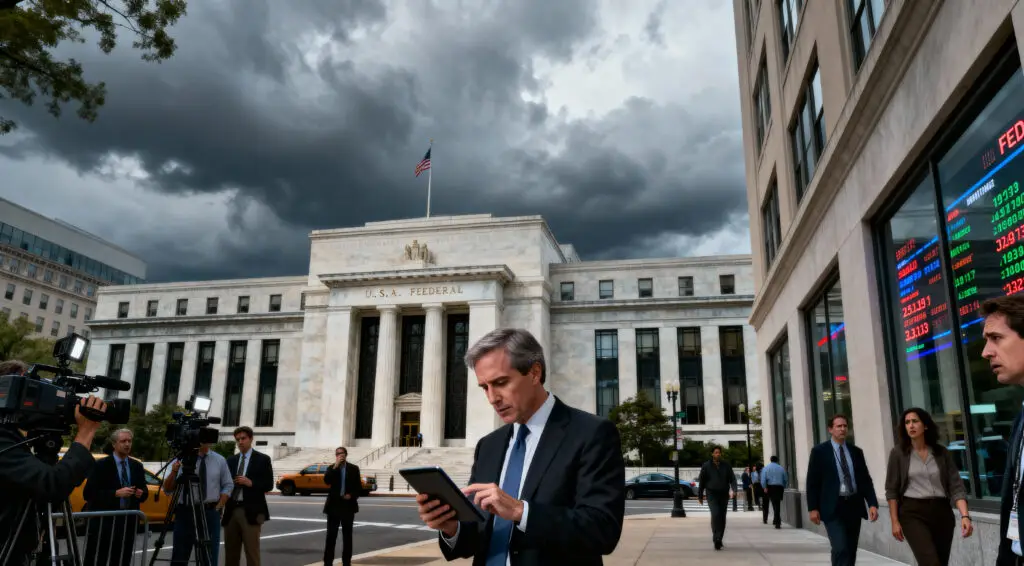Federal Reserve Announces Second Rate Cut This Year
The Federal Reserve of the United States has lowered its main interest rate by 25 basis points, bringing it down to between 3.75 and 4.00 percent. The move is the second rate cut of the year, which shows that the economy is slowing down and the government is being careful.
Officials said that the rate change was necessary because job creation was slowing, unemployment was growing, and inflationary pressure was still there. The message also underscored uncertainties around the larger economic outlook, reflecting global financial instability and local budgetary challenges.

Source: Invesco
Economists Expected the Policy Adjustment in Advance
The decision was in line with what economists who were following the CME FedWatch program thought would happen. It showed a 97.8 percent chance of reduction. Analysts from Goldman Sachs, Citigroup, and Morgan Stanley had also said that there would be at least two rate cuts before the end of the year.
Only Bank of America Global Research said that there would be no more cuts, which was not what most others in the sector thought. The move makes the Fed’s job of balancing promoting jobs and keeping inflation in check much harder, especially with political and economic challenges.
Powell Cautions Against Predicting Future Rate Decisions
Jerome Powell, the head of the Federal Reserve, made it clear that no final decision has been taken on possible changes in December. He made it clear that the central bank is still flexible and able to respond to any big developments in the economy as a whole.
Powell’s comments made it clear that monetary policy will continue to be based on facts, which will let the economy respond slowly to changes. He stressed that keeping stability in the labor and capital markets is still the institution’s top goal in 2025.
Recommended Article: Marcos Sees Stronger ASEAN Australia Partnership by 2026
Government Shutdown Limits Economic Data Availability
The government shutdown, which is currently in its 29th day, has made it hard for important federal economic statistics to be released. The Labor Department’s jobs report for September was canceled, which made it hard for experts to learn more about the current labor market.
The Consumer Price Index is still one of the few indications we have, and it went up 0.3 percent in September. Social Security has announced a 2.8 percent benefit increase for 2026 since the inflation rate is now 3 percent.
Weaker Confidence Reflects Growing Employment Anxiety
The Conference Board’s most recent research says that consumer confidence is at its lowest level in six months. People who make less than $75,000 a year are the most worried about the drop, saying they are afraid of job shortages getting worse.
In the past few weeks, big companies like Amazon, Target, and Paramount have said they would lay off thousands of workers. Economists say that if middle-class workers’ confidence keeps going down, it might hurt total spending in the last three months of 2025.
Private Sector Data Suggests Slowing Economic Activity
Throughout October, private analytics firms have said that output, hiring, and consumer demand have all gone down a little bit. The Fed’s decision to change interest rates in reaction to a weaker job market and a slowing inflation is backed up by these results.
Powell said that even if the government doesn’t report on the economy very often, private indicators can nevertheless show important changes. He also said that the Fed may still find big problems in the market even if it doesn’t have access to federal data.
Stock Markets React Cautiously to the Announcement
After the news, US markets opened in different directions as investors thought about what slower growth and easier policy might mean. By mid-afternoon in New York, the S&P 500 and the Dow Jones Industrial Average had both dropped around 0.3 percent.
The Nasdaq Composite, on the other hand, stayed the same, showing that investors are confident in technology’s ability to weather market turbulence. Analysts say that there will be some volatility in the near future as traders assess the possibility of future rate changes against incoming earnings reports.























